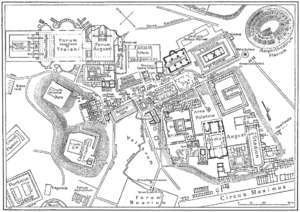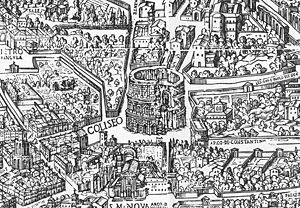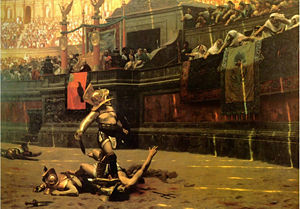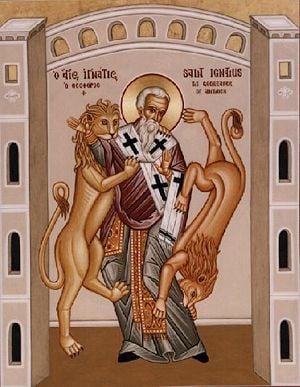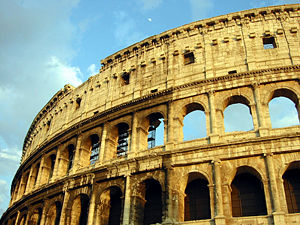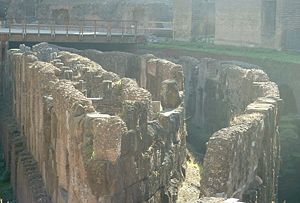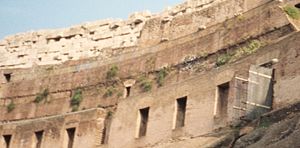Colosseum
The Colosseum or Coliseum, originally known as the Flavian Amphitheater (Latin: Amphitheatrum Flavium, Italian: Anfiteatro Flavio or Colosseo), is a giant amphitheater in the center of the city of Rome. Originally capable of seating 45,000 to 50,000 spectators, it was used for gladiatorial contests and public spectacles. It was built on a site just east of the Roman Forum, with construction starting between 70 and 72 C.E. under the emperor Vespasian. The amphitheater, the largest ever built in the Roman Empire, was completed in 80 C.E. under Titus, with further modifications being made during Domitian's reign
The Colosseum remained in use for nearly 500 years, with the last recorded games being held there as late as the sixth century—well after the traditional date of the fall of Rome in 476. As well as the traditional gladiatorial games, many other public spectacles were held there, such as mock sea battles, animal hunts, executions, re-enactments of famous battles, and dramas based on classical mythology. The building eventually ceased to be used for entertainment in the early medieval era. It was later reused for such varied purposes as housing, workshops, quarters for a religious order, a fortress, a quarry, and a Christian shrine.
Although it is now in a severely ruined condition due to damage caused by earthquakes and stone-robbers, the Colosseum has long been seen as an iconic symbol of Imperial Rome and is one of the finest surviving examples of Roman architecture. It is one of modern Rome's most popular tourist attractions and still has close connections with the Roman Catholic Church. The Pope leads a torchlit "Way of the Cross" procession to the amphitheater every Good Friday.
History
Ancient
Construction of the Colosseum began under the rule of the Emperor Vespasian around 70 to 72 C.E. The site chosen was a flat area on the floor of a low valley between the Caelian, Esquiline, and Palatine Hills, through which a canalized stream ran.
The area was devastated by the Great Fire of Rome in 64 C.E., following which Nero added much to his personal domain. He built the grandiose Domus Aurea on the site, in front of which he created an artificial lake surrounded by pavilions, gardens, and porticoes. The still-existing Aqua Claudia aqueduct was extended to supply water to the area, and the gigantic bronze Colossus of Nero was set up nearby at the entrance to the Domus Aurea.[1]
The area was transformed under the Emperor Vespasian and his successors. Although the Colossus was preserved, much of the Domus Aurea was torn down. The lake was filled in and the land reused as the location for the new Flavian Amphitheater, known more popularly today as the Colossuem. Gladiatorial schools and other support buildings were constructed nearby within the former grounds of the Domus Aurea. According to a reconstructed inscription found on the site: "The emperor Vespasian ordered this new amphitheater to be erected from his general's share of the booty." This is thought to refer to the vast quantity of treasure seized by the Romans following their victory in the Jewish Revolt, in 70 C.E.
The Colosseum can be thus interpreted as a great triumphal monument built in the Roman tradition of celebrating great victories. Vespasian's decision to build the Colosseum on the site of Nero's lake can also be seen as a populist gesture—in effect, returning to the people an area of the city which Nero had appropriated for his own use. It was built near the Roman Forum. By the second century B.C.E. the area was densely inhabited.
The Colosseum had been completed up to the third story by the time of Vespasian's death in 79 C.E. The top level was finished and the building inaugurated by his son, Titus, in 80 C.E. The historian Dio Cassius recounts that 11,000 wild animals were killed in gladiatorial contests during the 100 days of celebration which inaugurated the amphitheater. The building was remodeled further under Vespasian's younger son, the newly designated Emperor Domitian, who constructed the hypogeum, a series of underground tunnels used to house animals and slaves. He also added a gallery to the top of the Colosseum to increase its seating capacity.
In 217 C.E., the Colosseum was badly damaged by a major fire (caused by lightning, according to Dio Cassius), which destroyed the wooden, upper levels of the amphitheater's interior. It was not fully repaired until about 240 C.E. and underwent further repairs around 250 and again in 320. An inscription records the restoration of various parts of the Colosseum under Theodosius II and Valentinian III (reigned 425 to 450 C.E.), possibly to repair damage caused by an earthquake in 443 C.E. More work followed in 484 and 508. The arena continued to be used for contests well into the sixth century, with gladiatorial fights last mentioned around 435 C.E. Animal hunts continued until at least 523 C.E.
Medieval
The Colosseum underwent several radical changes of use during the medieval period. By the late sixth century a small church had been built into the structure of the amphitheater, though this apparently did not confer any particular religious significance on the building as a whole. The arena was converted into a cemetery. The numerous vaulted spaces in the arcades under the seating were converted into housing and workshops, and are recorded as still being rented out as late as the twelfth century. Around 1200, the Frangipani family took over the Colosseum and fortified it, apparently using it as a castle.
Severe damage was inflicted on the Colosseum by the great earthquake of 1349, causing the outer south side to collapse. Much of the tumbled stone was reused to build palaces, churches, hospitals, and other buildings elsewhere in Rome. The Order of Saint Salvator moved into the northern third of the Colosseum in the 1360s, and continued to inhabit it until as late as the early nineteenth century. In 1874, a religious dwelling at the Colosseum was no longer permitted when the structure was declared an archaeological and historic site by the Italian government.
The interior of the amphitheater was extensively stripped of stone, which was reused elsewhere, or (in the case of the marble facade) was burned to make quicklime. The bronze clamps which held the stonework together were pried or hacked out of the walls, leaving numerous pockmarks which still scar the building today.
Modern
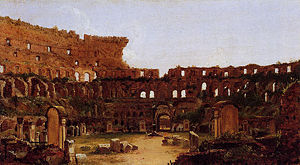
During the sixteenth century and seventeenth century, Church officials sought a productive role for the vast derelict hulk of the Colosseum. Pope Sixtus V (1585–1590) planned to turn the building into a wool factory to provide employment for Rome's prostitutes, though this proposal fell through with his premature death. In 1671, Cardinal Palluzzo Altieri used his powerful church positions, gained by being related to Pope Clement X, to authorize the Colosseum's use for bullfights. Although Cardinal of Ravenna at the time, Altieri was in the papal-appointed positions of Cardinal Nephew of the Pope and Manager of Affairs, a position even higher than Secretary of State at the Vatican. However, a public outcry over the "desecration" of the Colosseum caused the idea to be hastily abandoned when the Pope rescinded Altieri's bullfight order.
In 1749, Pope Benedict XIV endorsed as official Church policy the view that the Colosseum was a sacred site where early Christians had been martyred. He forbade the use of the Colosseum as a quarry and consecrated the building to the Passion of Christ and installed Stations of the Cross, declaring it sanctified by the blood of the Christian martyrs who perished there. Later popes initiated various stabilization and restoration projects, removing the extensive vegetation which had overgrown the structure and threatened to damage it further. The facade was reinforced with triangular brick wedges in 1807 and 1827, and the interior was repaired in 1831, 1846, and in the 1930s. The arena substructure was partly excavated in 1810–1814, and 1874, and was fully exposed under Mussolini in the 1930s.
The Colosseum is today one of Rome's most popular tourist attractions, receiving millions of visitors annually. The effects of pollution and general deterioration over time prompted a major restoration program carried out between 1993 and 2000, at a cost of $19.3 million. In recent years, it has become a symbol of the international campaign against capital punishment, which was abolished in Italy in 1948. Several anti–death penalty demonstrations took place in front of the Colosseum in 2000. Since that time, as a gesture against the death penalty, the local authorities change the color of the Colosseum's night-time illumination from white to gold whenever a person condemned to the death penalty anywhere in the world has their sentence commuted or is released.
Due to the ruined state of the interior, it is impractical to use the Colosseum to host large events; only a few hundred spectators can be accommodated in temporary seating. However, much larger concerts have been held just outside, using the Colosseum as a backdrop. Performers who have played at the Colosseum in recent years have included Ray Charles, Paul McCartney, and Elton John.
Uses
The Colosseum was used to host gladiatorial shows as well as a variety of other events. These shows, called munera, were staged by individuals rather than the state. They had a strong religious element but were also demonstrations of power and family prestige, and were immensely popular with the population.
Another popular type of show was the animal hunt, or venatio. This utilized a great variety of wild beasts, mainly imported from Africa, and included creatures such as rhinoceros, hippos, elephants, giraffes, lions, panthers, leopards, crocodiles, and ostriches. Battles and hunts were often staged amid elaborate sets with movable trees and buildings. Such events were occasionally on a huge scale. Trajan is said to have celebrated his victories in Dacia in 107 C.E. with contests involving 11,000 animals and 10,000 gladiators over the course of 123 days.
During the early days of the Colosseum, ancient writers recorded that the building was used for naumachiae—more properly known as navalia proelia—or simulated sea battles. Accounts of the inaugural games held by Titus in 80 C.E. describe it being filled with water for a display of specially trained swimming horses and bulls. There is also an account of a re-enactment of a famous sea battle between the Corcyrean (Corfiot) Greeks and the Corinthians. This has been the subject of some debate among historians. Although providing the water would not have been a problem, it is unclear how the arena could have been waterproofed, nor would there have been space in the arena for the warships to move around. It has been suggested that the reports either have the location wrong, or that the Colosseum originally featured a wide, floodable channel down its central axis.
Sylvae, or recreations of natural scenes, were also held in the arena. Painters, technicians, and architects would construct a simulation of a forest with real trees and bushes planted in the arena's floor. Animals would be introduced to populate the scene for the delight of the crowd. Such scenes might be used simply to display a natural environment for the urban population, or could otherwise be used as the backdrop for hunts or dramas depicting episodes from mythology. They were also occasionally used for executions in which the hero of the story—played by a condemned person—was killed in one of various gruesome but mythologically authentic ways, such as being mauled by beasts or burned to death.
Christians and the Colosseum
The Colosseum has long been regarded as having been the scene of numerous martyrdoms of early Christians. However, this belief appears to have arisen only around the sixteenth century. Roman and early medieval accounts refer to Christians being martyred in various vaguely described locations in Rome (in "the amphitheater," in "the arena," etc.). Saint Telemachus, for instance, is often said to have died in the Colosseum, but Theodoret's account of his death merely states that it happened "in the stadium" (eis to stadio). Similarly, the death of Saint Ignatius of Antioch is recorded as having been in "the arena," without specifying which arena. There were, in fact, numerous stadia, amphitheaters, and circuses in Rome.
In the Middle Ages, the Colosseum was not regarded as a sacred site. Its use as a fortress and then a quarry demonstrates how little spiritual importance was attached to it, at a time when sites associated with martyrs were highly venerated. It was not included in the itineraries compiled for the use of pilgrims nor in works such as the twelfth century Mirabilia Urbis Romae ("Marvels of the City of Rome"), which claims the Circus Flaminius—but not the Colosseum—as the site of martyrdoms.
In the sixteenth and seventeenth centuries, however, the Colosseum came to be regarded as a Christian site. Pope Pius V (1566-1572) is said to have recommended that pilgrims gather sand from the arena of the Colosseum to serve as a relic, on the grounds that it was impregnated with the blood of martyrs. This seems to have been a minority view until it was popularized nearly a century later by Fioravante Martinelli, who listed the Colosseum at the head of a list of places sacred to the martyrs in his 1653 book Roma ex ethnica sacra.
At the insistence of St. Leonard of Port Maurice, Pope Benedict XIV (1740-1758) forbade the ongoing quarrying of the Colosseum and erected Stations of the Cross around the interior of the arena, which remained until February 1874. St. Benedict Joseph Labre spent the later years of his life within the walls of the Colosseum, living on alms, prior to his death in 1783. Several nineteenth century popes funded repair and restoration work on the Colosseum, and it still retains a Christian connection today. Crosses stand in several points around the arena and every Good Friday the Pope leads a procession to the amphitheater in memory of Christian martyrs.[2]
Name
The Colosseum's name has long been believed to be derived from a colossal statue of Nero that stood nearby. This statue was later remodeled by Nero's successors into the likeness of Helios (Sol) or Apollo, the sun god, by adding the appropriate solar crown. Nero's head was also replaced several times and substituted with the heads of succeeding emperors. Despite its pagan links, the statue remained standing well into the medieval era and was credited with magical powers. It came to be seen as an iconic symbol of the permanence of Rome.
In the eighth century, the Venerable Bede (c. 672–735) wrote a famous epigram celebrating the symbolic significance of the statue: Quandiu stabit coliseus, stabit et Roma; quando cadit coliseus, cadet et Roma; quando cadet Roma, cadet et mundus ("As long as the Colossus stands, so shall Rome; when the Colossus falls, Rome shall fall; when Rome falls, so falls the world").[3] This is often mistranslated to refer to the Colosseum rather than the Colossus (as in, for instance, Byron's poem Childe Harold's Pilgrimage). However, at the time that Bede wrote, the masculine noun coliseus was applied to the statue rather than to what was then still known as the Flavian amphitheater.
The Colossus did eventually fall, having probably been pulled down to reuse its bronze. By the year 1000 C.E., the name "Colosseum" (a neuter noun) had been coined to refer to the amphitheater. The statue itself was largely forgotten and only its base survived, situated between the Colosseum and the nearby Temple of Roma and Venus.
Physical description
Exterior
The Colosseum measures 157 feet high, 615 feet long, and 510 feet wide, with a base area of six acres. Unlike earlier amphitheaters, it was an entirely free-standing structure, constructed on flat ground rather than being built into an existing hillside or natural depression. Its outer wall originally measured 1,788 feet, and is estimated to have required over 3.5 million cubic feet of travertine stone held together by 300 tons of iron clamps. However, it has suffered extensive damage over the centuries, with large segments having collapsed following earthquakes. The north side of the perimeter wall is still standing; the distinctive triangular brick wedges at each end are modern additions, having been constructed in the early nineteenth century to shore up the wall. The remainder of the present-day exterior of the Colosseum is in fact the original interior wall.
The surviving part of the outer wall's monumental façade comprises three stories of superimposed arcades surmounted by a podium on which stands a tall attic, both of which are pierced by windows interspersed at regular intervals. The arcades are framed by half-columns of the Doric, Ionic, and Corinthian orders, while the attic is decorated with Corinthian pilasters.[4] Each of the arches in the second- and third-floor arcades framed statues, probably honoring divinities and other figures from Classical mythology.
The Colosseum's huge crowd capacity made it essential that the venue could be filled or evacuated quickly. Its architects adopted solutions very similar to those used in modern stadiums to deal with the same problem. The amphitheater was ringed by 80 entrances at ground level, 76 of which were used by ordinary spectators. Each entrance and exit was numbered, as was each staircase. The northern main entrance was reserved for the Roman Emperor and his aides, while the other three axial entrances were most likely used by the elite. All four axial entrances were richly decorated with painted stucco reliefs, of which fragments survive. Many of the original outer entrances have disappeared with the collapse of the perimeter wall, but entrances XXIII to LIV still survive.
Spectators were given tickets in the form of numbered pottery shards, which directed them to the appropriate section and row. They accessed their seats via vomitoria (singular vomitorium), passageways that opened into a tier of seats from below or behind. These quickly dispersed people into their seats and, upon conclusion of the event or in an emergency evacuation, could permit their exit within only a few minutes. The name vomitoria derived from the Latin word for a rapid discharge, from which English derives the word vomit.
Interior seating
According to the Codex-Calendar of 354 C.E., the Colosseum could accommodate 87,000 people, although modern estimates put the figure at around 50,000. They were seated in a tiered arrangement that reflected the rigidly stratified nature of Roman society. Special boxes were provided at the north and south ends respectively for the Emperor and the Vestal Virgins, providing the best views of the arena. Flanking them at the same level was a broad platform or podium for the senatorial class, who were allowed to bring their own chairs. The names of some fifth century senators can still be seen carved into the stonework, presumably reserving areas for their use.
The tier above the senators, known as the maenianum primum, was occupied by the non-senatorial noble class or knights (equites). The next level up, the maenianum secundum, was originally reserved for ordinary Roman citizens (plebians) and was divided into two sections. The lower part (the immum) was for wealthy citizens, while the upper part (the summum) was for poor citizens. Specific sectors were provided for other social groups: For instance, boys with their tutors, soldiers on leave, foreign dignitaries, scribes, heralds, priests, and so on. Stone (and later marble) seating was provided for the citizens and nobles, who presumably would have brought their own cushions with them. Inscriptions identified the areas reserved for specific groups.
Another level, the maenianum secundum in legneis, was added at the very top of the building during the reign of Domitian. This comprised a gallery for the common poor, slaves, and women. It would have been either standing room only, or would have had very steep, wooden benches. Some groups were banned altogether from the Colosseum, notably gravediggers, actors, and former gladiators.[5]
Arena and hypogeum
The arena itself measured 272 feet by 157 feet. It was comprised of a wooden floor covered by sand (the Latin word for sand is harena or arena), covering an elaborate underground structure called the hypogeum (literally meaning "underground"). Little now remains of the original arena floor, but the hypogeum is still clearly visible. It consisted of a two-level, subterranean network of tunnels and cages beneath the arena where gladiators and animals were held before contests began. Eighty vertical shafts provided instant access to the arena for caged animals and scenery pieces concealed underneath; larger hinged platforms, called hegmata, provided access for elephants and the like. It was restructured on numerous occasions; at least 12 different phases of construction can be seen.
The hypogeum was connected by underground tunnels to a number of points outside the Colosseum. Animals and performers were brought through the tunnel from nearby stables, with the gladiators' barracks at the Ludus Magnus to the east also being connected by tunnels. Separate tunnels were provided for the Emperor and the Vestal Virgins to permit them to enter and exit the Colosseum without needing to pass through the crowds.
Substantial quantities of machinery also existed in the hypogeum. Elevators and pulleys raised and lowered scenery and props, as well as lifting caged animals to the surface for release. There is evidence for the existence of major hydraulic mechanisms and according to ancient accounts, it was possible to flood the arena rapidly, presumably via a connection to a nearby aqueduct.
Supporting buildings
The Colosseum and its activities supported a substantial industry in the area. In addition to the amphitheater itself, many other buildings nearby were linked to the games. Immediately to the east are the remains of the Ludus Magnus, a training school for gladiators. This was connected to the Colosseum by an underground passage, to allow easy access for the gladiators. The Ludus Magnus had its own miniature training arena, which was itself a popular attraction for Roman spectators. Other training schools were in the same area, including the Ludus Matutinus (Morning School), where fighters of animals were trained, plus the Dacian and Gallic Schools.
Also nearby were the Armamentarium, comprising an armory to store weapons; the Summum Choragium, where machinery was stored; the Sanitarium, which had facilities to treat wounded gladiators; and the Spoliarium, where bodies of dead gladiators were stripped of their armor and disposed of.
Around the perimeter of the Colosseum, at a distance of 59 feet from the perimeter, was a series of tall stone posts, with five remaining on the eastern side. Various explanations have been advanced for their presence; they may have been a religious boundary, or an outer boundary for ticket checks, or an anchor for the velarium, or awning.
Flora
The Colosseum has a wide and well-documented history of flora, ever since Domenico Panaroli made the first catalog of its plants in 1643. Since then, 684 species have been identified there. The peak was in 1855 (420 species). Attempts were made in 1871 to eradicate the vegetation, due to concerns over the damage that was being caused to the masonry, but much of it has returned. Today, 242 species have been counted, and of the species first identified by Panaroli, 200 remain.
The variation of plants can be explained by the change of climate in Rome through the centuries. Additionally, bird migration, flower blooming, and the growth of Rome that caused the Colosseum to become embedded within the modern city center rather than on the outskirts of the ancient city, as well as the deliberate transport of species, are all contributing causes. One other romantic reason often given is that their seeds being unwittingly transported on the animals brought there from all corners of the empire.
Notes
- ↑ Amanda Claridge, Rome: An Oxford Archaeological Guide (Oxford: Oxford University Press, 1998). ISBN 0-19-288003-9
- ↑ Catholic Encyclopedia, The Coliseum. Retrieved May 28, 2007.
- ↑ Ibid.
- ↑ Ian Archibald Richmond, Donald Emrys Strong, Janet DeLaine, "Colosseum," The Oxford Companion to Classical Civilization (Ed. Simon Hornblower and Antony Spawforth, Oxford University Press, 1998). ISBN 0198601654
- ↑ Samuel Ball Platner (as completed and revised by Thomas Ashby), A Topographical Dictionary of Ancient Rome (Oxford University Press, 1929). Retrieved May 28, 2007.
ReferencesISBN links support NWE through referral fees
- Claridge, Amanda. Rome: An Oxford Archaeological Guide. Oxford University Press, 1998. ISBN 0-19-288003-9
- Gabuccie, Ada. The Colosseum. Getty Trust Publications, 2002. ISBN 978-0892366484
- Hopkins, Keith and Mary Beard. The Colosseum. Harvard University Press, 2005. ISBN 0-674-01895-8
- Hornblower, Simon and Antony Spawforth, ed. The Oxford Companion to Classical Civilization. Oxford University Press, 1998. ISBN 978-0198609582
- Mann, Elizabeth and Michael Racz. The Roman Colosseum: The Story of the World's Most Famous Stadium and Its Deadly Games. Mikaya Press, 2006. ISBN 978-1931414173
- Nardo, Don. The Roman Colosseum. Lucent Books, 1998. ISBN 978-1560064299
External links
All links retrieved January 7, 2024.
- The Colosseum, Rome virtual reality movies and free audio guide for iPod or MP3, www.italyguides.it.
- The COLOSSEUM A Roman amphitheater site. www.the-colosseum.net.
Credits
New World Encyclopedia writers and editors rewrote and completed the Wikipedia article in accordance with New World Encyclopedia standards. This article abides by terms of the Creative Commons CC-by-sa 3.0 License (CC-by-sa), which may be used and disseminated with proper attribution. Credit is due under the terms of this license that can reference both the New World Encyclopedia contributors and the selfless volunteer contributors of the Wikimedia Foundation. To cite this article click here for a list of acceptable citing formats.The history of earlier contributions by wikipedians is accessible to researchers here:
The history of this article since it was imported to New World Encyclopedia:
Note: Some restrictions may apply to use of individual images which are separately licensed.

